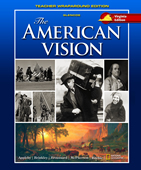

The American Vision © 2011 Virginia EditionUnit 8: A Time of Upheaval, 1954-1980Historical Thinking ActivitiesAssignment: Analyzing Positions on the Vietnam War In their speeches and written documents on Vietnam, public figures often mingled arguments. When you analyze primary sources that are meant to persuade, it is important to scrutinize them closely and separate them logically—you want to break each argument into its simplest component. This is what you will do with the sources below before you write up your analysis of 1) how persuasive the speakers or writers are; and 2) how well they are responding to each other's arguments. Assignment Task List Step 2: Review your textbook's material on the Vietnam War to remind yourself of the general course of the war and of shifts in public opinion. Step 3: Read all of the primary sources below, researching the author where necessary. The sites for each are listed in order. Lyndon Baines Johnson Library and Museum CNN Interactive: Vietnam George Washington University, National Security Archive Time: The Debate Step 4: For each source, list the different arguments being made. There could be only one argument, but there might well be more than one (Someone could for example, say the war is too expensive and the war costs too many American lives—those are two arguments.) Step 5: Compare your lists to see whether the arguments are about different issues or the same issue (but taking an opposite point of view). Step 6: Write up a report on your comparison. In your report, answer these questions: Were the people addressing the same issues? Did you find one or another speaker or writer more persuasive? Why? Step 7: Review your work against the checklist below. Revise your report as necessary.
|  | ||||||||















